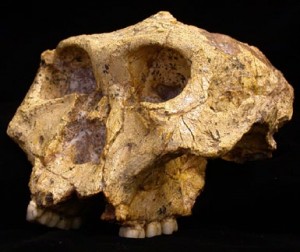The males of the two bipedal hominid species that roamed the South African savannah more than a million years ago were stay-at-home kind of guys when compared to the gadabout gals, says a new high-tech study led by the University of Colorado Boulder. Dr Petrus le Roux from the Department of Geological Sciences at UCT was part of a team which studied teeth from a group of extinct Australopithecus africanus and Paranthropus robustus individuals from two adjacent cave systems in the Sterkfontein-Swartkrans area in South Africa.
 The research team used high-tech laser ablation mass spectrometry to measure isotope ratios of strontium in the hominid tooth enamel in order to identify specific areas of landscape use. A naturally occurring element, strontium, is found in rocks and soils and is absorbed by plants and animals and becomes incorporated in the enamel of their teeth during development. Since unique strontium signals are tied to specific geological substrates – like granite, basalt, quartzite, sandstone and others, they can be used to reveal landscape conditions where ancient hominids grew up Sandi Copeland, UC Boulder Adjunct Professor and lead study author explains, “The strontium isotope ratios are a direct reflection of the foods these hominids ate, which in turn are a reflection of the local geology”. The researchers found that the strontium isotope signals in half of the female teeth indicated that they were derived from outside the local area, which contrasted with that of the males. In the latter only about ten percent suggested that they were from elsewhere, implying that the males probably grew up and died in the same area. Sandi Copeland said, “One of our goals was to try and find something out about early hominid landscape use. Here we have the first direct glimpse of the geographic movements of early hominids, and it appears the females preferentially moved away from their residential groups.” She said that the new study results were somewhat surprising as they had assumed that more of the hominids would be from non-local areas, as it is generally thought that the evolution of bipedalism was due in part to allow individuals to range longer distances. “Such small home ranges could imply that bipedalism evolved for other reasons”, Copeland said.
The research team used high-tech laser ablation mass spectrometry to measure isotope ratios of strontium in the hominid tooth enamel in order to identify specific areas of landscape use. A naturally occurring element, strontium, is found in rocks and soils and is absorbed by plants and animals and becomes incorporated in the enamel of their teeth during development. Since unique strontium signals are tied to specific geological substrates – like granite, basalt, quartzite, sandstone and others, they can be used to reveal landscape conditions where ancient hominids grew up Sandi Copeland, UC Boulder Adjunct Professor and lead study author explains, “The strontium isotope ratios are a direct reflection of the foods these hominids ate, which in turn are a reflection of the local geology”. The researchers found that the strontium isotope signals in half of the female teeth indicated that they were derived from outside the local area, which contrasted with that of the males. In the latter only about ten percent suggested that they were from elsewhere, implying that the males probably grew up and died in the same area. Sandi Copeland said, “One of our goals was to try and find something out about early hominid landscape use. Here we have the first direct glimpse of the geographic movements of early hominids, and it appears the females preferentially moved away from their residential groups.” She said that the new study results were somewhat surprising as they had assumed that more of the hominids would be from non-local areas, as it is generally thought that the evolution of bipedalism was due in part to allow individuals to range longer distances. “Such small home ranges could imply that bipedalism evolved for other reasons”, Copeland said.
Professor Matt Sponheimer, UC-Boulder anthropologist and a co-author of the article, says, “It is difficult enough to work out relations between the sexes today, so the challenges in investigating the ways that male and female hominids used the landscape and formed social groups over a million years ago, are considerable. Disembodied skulls and teeth are notoriously poor communicators, so the real difficulty with a study like this is finding new ways to make these old bones speak”. The female dispersal pattern seen in the two hominid groups is similar to that of many modern humans, chimpanzees and bonobos, but unlike most other primates, including gorillas, where one or two males dominate a group of females, explained Copeland. “This study gets us closer to understanding the social structures of ancient hominids, since we now have a better idea about the dispersal patterns”, she said.
From:
Contact: University of Cape Town, Faculty of Science Newsletter, March 2012, Page 11







Recent Comments